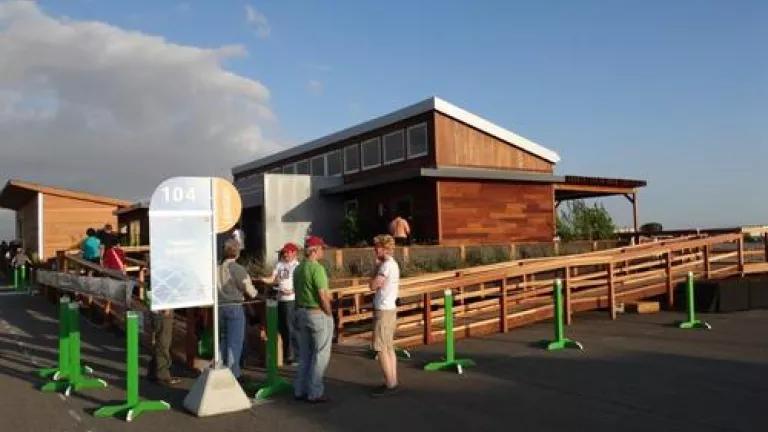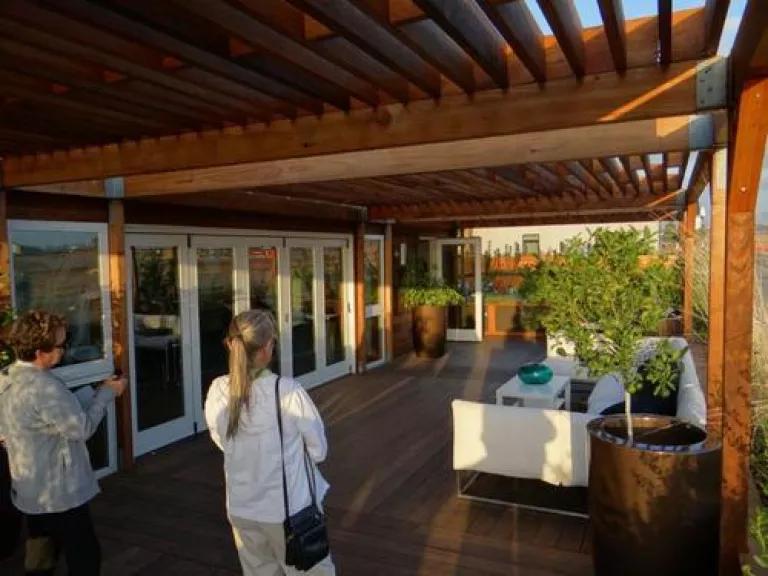
Silicon Valley is a hub of clean energy innovation, home to a host of companies and start-ups that include electric vehicle manufacturer Tesla and solar leasers Solar City. The place is even the location for California’s first (and, so far, only) Smart Energy Enterprise Development Zone, an 8 square-mile region designed to foster the implementation of clean energy and smart-grid technologies.
It’s no surprise, then, that in keeping with this clean-techy vibe, Palo Alto-based Stanford University is making a strong showing in the 10-day 2013 Solar Decathlon, going on now through October 13th in Irvine, California. In fact, they’re in first place as of this posting. (The Decathlon, administered by the Department of Energy’s National Renewable Energy Lab, continues despite the federal government shutdown, not because it’s considered an essential government service, unfortunately, but because it was both pre-funded and significantly underwritten by private donors.)
Stanford's Start.Home on display at this year's Solar Decathlon. It's building controls beautifully meld art and technology, while teaching users to better their environmental footprint.
The biannual event, currently in its 11th year, brings college and university student teams from around the country and around the world together to forward green building and solar innovation and to give students the kind of hands-on experience they need to become leaders in both fields.
From the very beginning, the Stanford team decided it wanted to do something that could described positively in business circles as “disruptive”—something that up-ends the way things are currently done. The team hoped its Start.Home, as its house is called, would change the way the building industry works and the way residents interact with their living spaces.
The first element in that disruption is what Stanford calls the house’s “core”—essentially, its working parts: the mechanical room, the plumbing, the appliance hook-ups. (The “muscle, brains and heart of our home,” the team says.) Usually, when a house is built, these are installed onsite. But what if, much like a car, they could be pre-engineered and pre-assembled, then shipped directly? That might enable homebuilders to use the latest in sustainable technologies, even in areas where green building has yet to take hold, and to cut costs and energy expenditures, too. Start.Home’s core is the prototype for what could well become, in an established Stanford tradition (think: Sergey Brin and Larry Page), a successful start-up enterprise.
Stanford’s other disruptive innovation is to change the way residents interact with their home’s energy- and water-consuming elements—the lighting, the appliances, the sinks and the showers. “Designing for agency,” team leader Derek Ouyang calls it.

Like all Solar Decathlon entries, Stanford's Start.Home integrates indoor and outdoor living spaces.
Consider this: If you automate these controls—a standard high-tech technique for making controls easy to use—you get a single sustainable home. But what if the controls provide ongoing feedback that teaches residents about their energy and water usage? Then, they not only learn about what works but, the Stanford team hopes, they can then go out and teach that to the many people they interact with every day. Explains Ouyang: “You get a sustainable community.”
Designing these controls was a dream project for Jason Bade, who’d graduated from Stanford this spring. It was, in fact, the kind of educational experience he probably couldn’t have found anywhere else. “It wasn’t like a corporate internship or a summer job,” he explains. “You’re allowed this degree of freedom and creativity because you don’t have to design for a mass scale.” At the same time, “you get a crash course in business realities, like running a team and meeting deadlines.”
Whether the Stanford team wins the competition or starts its own company is perhaps beside the point. With the federal government’s help, students like Bade, Ouyang and their teammate (and NRDC summer MAP fellow) Ryan Satterlee are bringing advances to homebuilding—advances that can change the way we produce and use energy as a nation. Those kinds of innovation are both a Silicon Valley hallmark, to be sure.
